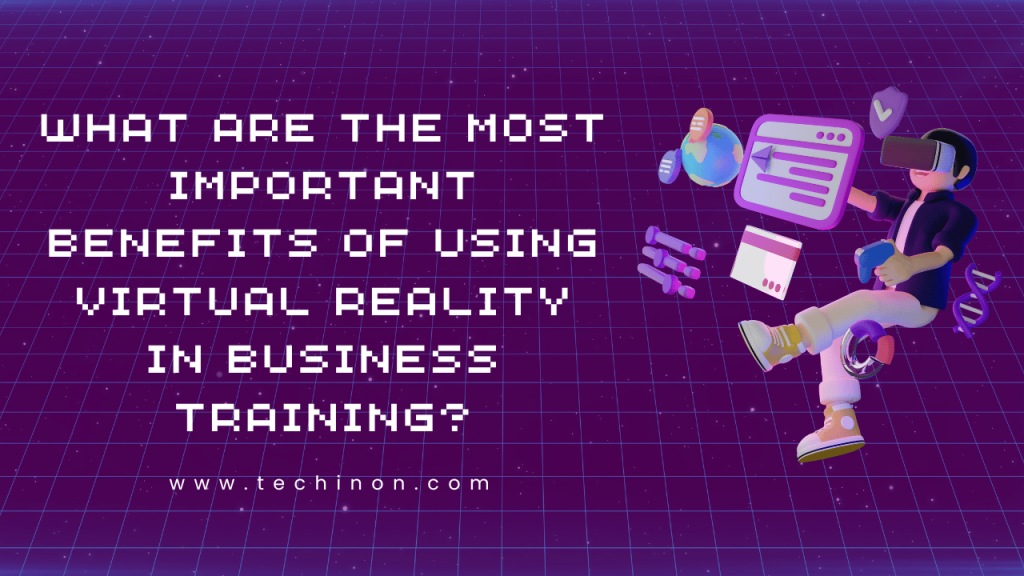Introduction
In a rapidly evolving business landscape, traditional training methods are giving way to more innovative and engaging approaches. Among the frontiers of this revolution is the integration of Virtual Reality (VR) into business training. This article, penned by experts in the field, dives into what are the most important benefits of using virtual reality in business training and success stories.
How Does Virtual Reality Enhance Business Training?
Virtual reality offers a whole new level of engagement and interaction that’s unprecedented in traditional training methods.
1. Immersive Training Benefits in Business
With VR simulations for corporate learning, employees are immersed in a realistic environment where they can practice and refine their skills. This immersive approach fosters faster learning and greater retention.
2. Virtual Reality Technology for Training
VR technology supports diverse learning styles, catering to visual, auditory, and kinesthetic learners. This tailored approach enhances understanding and application in real-world scenarios.
What are the Advantages of Using VR in Corporate Training?

The advantages of VR in corporate training are both vast and substantial.
1. Virtual Reality for Workforce Development
Investing in VR-based employee onboarding can accelerate the integration of new hires into the company culture, boosting morale and productivity.
2. Advantages of VR in Employee Training
Virtual reality training advantages go beyond just skill acquisition; they offer unparalleled opportunities for collaboration, innovation, and problem-solving.
Can Virtual Reality Improve Employee Learning and Development?
Certainly! The use of virtual reality for skill development in business is an area where VR has proven exceptionally effective.
1. Impact of Virtual Reality in Professional Development
VR training applications in business are demonstrating quantifiable improvements in performance and a reduction in training time, setting new standards in professional development.
2. VR-based Learning Advantages in the Workplace
The benefits of incorporating VR into training programs include increased engagement, a closer alignment with real-world applications, and the possibility to practice without risks.
What Industries are Adopting Virtual Reality for Employee Development?

From healthcare to manufacturing, various industries are leveraging virtual reality technology for training.
1. Benefits of VR-based Employee Onboarding
In customer service sectors, VR simulations for workforce training are reducing onboarding time and increasing efficiency.
2. Virtual Reality for Skill Development in Business
Tech industries are utilizing VR training applications for complex problem-solving and team-building exercises, creating a competitive edge.
Are There Any Success Stories of Companies Using Virtual Reality for Training?
Absolutely! Virtual reality has been employed by many companies with immense success. Here’s how:
1. Reducing Training Costs
Several companies have reported significant cost savings associated with VR training in business. By shifting to virtual simulations, businesses reduce the need for physical resources and minimize travel expenses.
2. Enhancing Safety Training
Industries like construction and mining are using VR simulations to train employees in safety protocols within virtual environments that replicate potential hazards, drastically reducing the risk of on-site accidents.
What Skills Can be Effectively Trained Using Virtual Reality in the Workplace?

Virtual reality’s adaptability makes it suitable for training various skills.
1. Technical Skills Development
Through VR-based learning advantages in the workplace, employees can master complex machinery operations, programming languages, and other specialized tasks.
2. Soft Skills Enhancement
Virtual reality for skill development in business extends to soft skills, such as communication, leadership, and emotional intelligence. VR simulations create scenarios that allow for real-time feedback and adjustment.
How Does VR Technology Impact Employee Onboarding in Businesses?
Integrating VR into the onboarding process has profound impacts.
1. Accelerating Integration
Virtual reality training advantages in onboarding include faster integration of new employees into teams and roles, fostering a cohesive and productive work environment from the start.
2. Enhancing Cultural Understanding
Benefits of VR-based employee onboarding encompass the alignment of new hires with company values and culture. Through interactive virtual tours and simulations, newcomers quickly grasp the essence of the organization.
Can VR-Based Training Improve Retention and Engagement in Employees?
Yes! Here’s how:
1. Creating Engaging Experiences
VR benefits for corporate training involve crafting engaging experiences that captivate employees, making learning enjoyable and memorable, which ultimately improves retention rates.
2. Continuous Development Opportunities
With virtual reality for workforce development, continuous learning is facilitated, leading to sustained engagement and motivation among employees.
Are There Any Specific VR Training Solutions Tailored to Different Industries?

Indeed, VR offers versatile solutions across various industries.
1. Healthcare
Healthcare professionals are using VR simulations for intricate surgical training, patient care scenarios, and even empathy training.
2. Manufacturing
Virtual reality technology for training in manufacturing covers assembly processes, quality control, and maintenance, leading to fewer errors and enhanced productivity.
3. Hospitality
In the hospitality sector, VR-based learning advantages include training staff in customer service, culinary arts, and hotel management.
What are the Potential Challenges of Implementing VR Training?
Although the benefits are substantial, challenges can arise.
1. Initial Investment Costs
While VR benefits may significantly outweigh costs in the long run, initial investment in hardware and software can be substantial.
2. Technological Adaptation
The transition to virtual reality technology for training may require a learning curve for both facilitators and learners, demanding time and effort in adaptation.
How Does Virtual Reality Compare to Traditional Training Methods in Business?
The comparison between virtual reality (VR) and traditional training methods reveals remarkable distinctions.
1. Interactivity and Engagement
Unlike conventional approaches, virtual reality for workforce development fosters interactivity and engagement, transforming learning into an experiential process rather than mere information absorption.
2. Cost Efficiency Over Time
Though initial costs may be higher, the advantages of VR in employee training include long-term savings by minimizing recurring expenses for trainers, venues, and materials.
3. Scalability and Flexibility
Virtual reality training advantages entail scalability and flexibility, allowing businesses to accommodate varying employee numbers and diverse learning needs without logistical challenges.
Are There Any Cost Savings Associated with VR Training in Business?
Yes, integrating VR into business training can lead to significant cost savings.
1. Reduction in Travel Costs
Training that requires travel can be expensive. VR benefits for corporate training include virtual meetings and training sessions, substantially cutting down travel expenses.
2. Long-term Savings on Training Materials
The benefits of VR-based employee onboarding and continuous training translate to reduced spending on physical materials, as digital assets can be reused and easily updated.
What Are the Benefits of Using VR Simulations for Workforce Training?
The application of VR simulations offers a plethora of benefits.
1. Realistic Practice Environments
VR simulations for corporate learning provide lifelike environments where employees can practice without real-world consequences, increasing confidence and competence.
2. Instant Feedback Mechanisms
With virtual reality technology for training, immediate feedback allows for on-the-spot corrections, accelerating learning curves, and maximizing training effectiveness.
How Can Virtual Reality Enhance Remote Training and Collaboration?
As remote work becomes more prevalent, VR’s role in training and collaboration becomes increasingly vital.
1. Facilitating Remote Team Collaboration
Virtual reality technology for training fosters remote collaboration by creating shared virtual spaces where teams can interact, brainstorm, and work on projects as if they were in the same room.
2. Remote Skill Development
Through VR-based learning advantages in the workplace, remote employees can access the same quality of training as on-site personnel, maintaining consistent quality and standards across different locations.
What Are Some Emerging Trends in Virtual Reality Training?
Virtual reality is continuously evolving, and some emerging trends are reshaping the way businesses approach training.
1. Integration with AI for Personalized Training
The blend of VR and AI allows for more personalized training experiences, adjusting scenarios and feedback to individual needs, thus amplifying the impact of virtual reality in professional development.
2. Augmented Reality (AR) Hybrid Models
Combining VR with AR introduces more versatile training options, creating hybrid environments where virtual objects are integrated with the real world, extending the virtual reality training advantages.
3. Mobile VR Solutions
The advent of mobile VR solutions is democratizing access to virtual reality technology for training, making it more accessible and adaptable to various business needs and sizes.
Frequently Asked Questions On What are the Most Important Benefits of Using Virtual Reality in Business Training?
Why Should Businesses Invest in VR-based Training Programs?
Investing in VR enhances corporate training by fostering skill development, improving retention, and offering customizable training solutions.
Are There Any Studies Supporting the Effectiveness of VR in Business Training?
Yes, numerous studies validate the effectiveness of VR in enhancing learning and development in the business context.
What Are the Potential Drawbacks or Challenges of Implementing VR Training?
While overwhelmingly positive, the challenges may include initial setup costs and adapting to new technology.
Also Read: Beautiful Short Gown Styles [2023]
Conclusion
Virtual reality in business training is no longer just a vision of the future; it’s here, and its impact is profound. From its unique capabilities in creating immersive learning environments to its potential in remote collaboration, VR is transforming the way businesses educate, develop, and innovate.
The wave of virtual reality is sweeping across industries, defining new norms, and setting higher standards. Join the revolution, leverage the limitless possibilities, and take your business training to unprecedented heights.
To conclude, our aim with this article on “What are the Most Important Benefits of Using Virtual Reality in Business Training?” has been to equip you with the necessary tools and knowledge to make informed decisions and overcome any challenges you may encounter.
Iva Ort is an ingenious wordsmith and captivating blogger whose tales leap off the screen and into your imagination. With a pen as her wand, she weaves enchanting stories and insightful articles, leaving readers spellbound and craving more.

